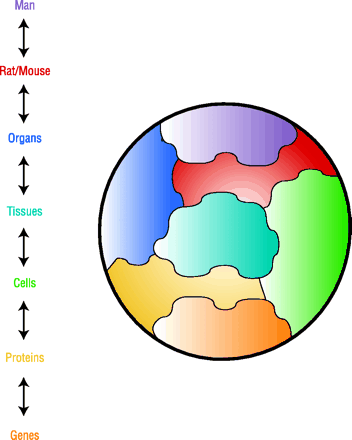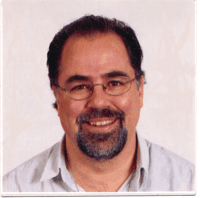Systems and Integrative Pharmacology: Putting the Puzzle Pieces Together
- George J. Christ, PhD
- George J. Christ, PhD, is Chair, Division of Systems & Integrative Pharmacology for ASPET, Professor of Urology and of Physiology & Pharmacology, and Head of the Program in Cell, Tissue & Organ Physiology at Wake Forest Institute for Regenerative Medicine, Winston-Salem, NC. E-mail gchrist{at}wfubmc.edu; fax 336-713–7290.
The postgenomic age presents enormous challenges and opportunities for pharmacologists to participate in translational research, with the ultimate goal being the improved understanding, diagnosis, and treatment of human diseases and disorders. The goal of this article is twofold: 1) to briefly frame the general scientific climate and the role of pharmacology in the age of molecular medicine; and 2) to describe the agenda, activities, and initiatives of the Division of Systems and Integrative Pharmacology (DSIP) in the American Society for Pharmacology and Experimental Therapeutics (ASPET).
The Role of Pharmacology in the Age of Molecular Medicine
This promising new era of molecular medicine has ushered in an explosion of new scientific terms, including a veritable “omics” revolution that encompasses such burgeoning areas of research as proteomics, transcriptomics, and metabolomics. More integrative terms, such as “functional genomics,” refer to the process whereby specific physiological properties and/or pathophysiological alterations are ascribed to discrete molecular or genetic entities. “Systems biology,” on the other hand, has a similar connotation but casts a much wider net, focusing on larger integrated sets of genes and their relationship to various physiological and pathophysiological processes at the tissue, organ, and whole-animal levels (1). Regardless of the terms used, the successful scientists of the future will find an answer, or at the very least, a partial solution to the following question: How can we best leverage the enormity of the available molecular database and harness the vast and powerful new technologies that are being developed to improve the understanding, diagnosis, and treatment of human disease? That is, how do we put all of the puzzle pieces together correctly? (See image at right.)
Certainly, this question generates much conversation around water coolers and coffee stations in diverse scientific, clinical, and industrial settings throughout the world. As pharmacologists, we are ideally positioned to benefit from this molecular revolution. In fact, an excellent recent report outlines many of the relevant issues confronting the academic pharmacology community in the “omics” revolution (2). This same article outlines some potential approaches to re-establish the prominence of the academic pharmacologist in the process; the subject will not be further elaborated herein, but the interested reader is strongly encouraged to review this important material for further details.
As an initial step to address the recognized dearth of integrative and systems pharmacologists, the National Institute of General Medical Sciences (NIGMS) has recently released a Request for Applications (GM-05-006) entitled: “Short Course in Integrative and Organ Systems Pharmacology.” As described in detail in a previous issue of Molecular Interventions, this novel, seminal educational and training program provides the “seed” money to begin developing the next generation of integrative pharmacologists (3). Although the application deadline for this RFA has expired, the online description is quite interesting and can be found at http://grants.nih.gov/grants/guide/rfa-files/RFA-GM-05-006.html. Obviously, the success of such initiatives is critical to ensure that students, postdoctoral fellows, and junior faculty will continue to be trained in whole animal and organ systems pharmacology, and moreover, that these individuals will be prepared to assume leadership and career development positions within the private (i.e., pharmaceutical and biotechnology companies), government, or academic sectors.

A series of 3-D interlocking puzzle pieces serves to illustrate the complexities facing pharmacologists interested in systems and integrative pharmacology. In order to understand the “System” we will not only have to complete the puzzles that exist at each level of complexity, but we will also need to determine how these levels interact and interconnect, and then “Integrate” that information into a more complete picture of the whole.
The Goals and Roles of DSIP
DSIP provides a venue for discussions concerning the research, training, and education issues critical to the continued success and prominence of pharmacology in the postgenomic era. In fact, DSIP strives to be the centerpiece for ASPET in this arena. The remainder of this report will describe some of our ongoing efforts and initiatives to this end, with the hope that this information will excite interest and encourage the participation of individuals with varied pharmacological expertise (i.e., molecular, cellular, tissue, organ systems, and whole-animal pharmacologists).
DSIP was formed only a few years ago to raise awareness that too few individuals were being trained and educated in whole-animal and organ systems pharmacology. Consistent with the DSIP mission, the Executive Committee is composed of an approximately equal mix of academic and industrial scientists, and all ASPET members are welcome and encouraged to join the Division. Some pertinent information concerning the general mission and composition of DSIP is available on our Web site (http://www.aspet.org/public/divisions/SIP_div.htm).
So, what exactly is meant by systems and integrative pharmacology, and what exactly is the necessity for maintaining such expertise? Peter Preusch of the NIGMS has provided codification of the essential points: “NIGMS defines Integrative and Organ Systems Pharmacology (IOSP) as ‘pharmacological research using in vivo animal models or substantially intact organ systems that are able to display the integrated responses characteristic of the living organism that results from complex interactions between molecules, cells, and tissues. Such studies are important because isolated molecules and cells in vitro do not necessarily reflect the properties that they possess in vivo and cannot adequately reflect the function of intact tissues, organs and organ systems’.”
When viewed in this context, maintaining a cadre of individuals with expertise in this area will undoubtedly be critical for the sensible application of genomic and proteomic information and technologies to target, for example, validation and drug discovery efforts as well as the development of improved diagnostics. Such expertise is clearly a cornerstone for improved therapeutics and diagnostics for human disease, and thus, the pharmaceutical and biotechnology sectors are highly interested in identifying people with such training and skills. Again, the intent of DSIP is to provide not only a mechanism for promoting research, education, and training at the whole-animal and organ systems level but also a venue for conversations, more formal discussions, and interactions among scientists of diverse training and backgrounds that will best facilitate this laudable goal. Above all, DSIP seeks to promote cross-fertilization of scientific ideas and the application of new and existing technologies across a broad spectrum of scientific fields and pharmacological subdisciplines. As described in more detail below, DSIP truly seeks strength through integration of diverse expertise.
Some DSIP Initiatives
In order to achieve its aims, DSIP seeks to build bridges to the other Divisions within ASPET, as well as with other relevant entities, organizations, and societies in both academia and industry. We are currently evaluating a variety of mechanisms to increase both student and faculty involvement in the Division. For example, we continue to recognize excellence in integrative pharmacology through graduate and postdoctoral poster and podium awards at pharmacology meetings. In fact, this year, we granted graduate student poster awards at the Experimental Biology 2004 (EB2004) meeting and we have spawned appreciation for our discipline at regional pharmacological society meetings [e.g., Mid-Atlantic Pharmacology Society (MAPS) and Southeastern Pharmacology Society (SEPS)].
With the streamlining of pharmaceutical companies and the advent of biotechnology companies in recent years, DSIP has encouraged opportunities for academic pharmacologists to get involved in preclinical contract research work. The benefits of this to the academic pharmacologist are manifold and have been outlined by DSIP Past-Chair Jerry Buccafusco: 1) Enhanced funding to the laboratory; 2) increased publications; 3) participation in applied research objectives; and 4) the attraction of interested graduate students to the laboratory. Although this is clearly not a long-term solution to the shortage of pharmacologists trained in systems-based research, it is a good starting point, and it provides good exposure of graduate students and postdoctoral fellows to the pharmaceutical and biotechnology sectors.
Another potentially enormous research opportunity for academic pharmacologists is present in the availability of vast numbers of transgenic mice. This scientific arena bridges molecular genetics to SIP; physiological and pharmacological data mining is crucial to better understand how manipulation, mutation, or ablation of a particular molecular target affects the tissue, organ, and whole animal. DSIP is an excellent venue for discussing such exciting possibilities, and for continuing to promote an agenda that ensures that people qualified to conduct such studies are available.
The integration and diversity of our Division is also reflected in the symposia that we are sponsoring (2 symposia) and co-sponsoring (6 symposia) at EB 2005. One DSIP-sponsored symposium, organized by Ismail Laher (University of British Columbia) and Harm Knot (University of Florida), is entitled “20 Years of Calcium Imaging: A Revolution in Cell Physiology to Dye For.” This exciting program will review how the advent of fluorescent markers for intracellular calcium, exactly twenty years ago (4), has altered our understanding of cell functioning in a very fundamental way. Leaders in various fields covering major organ systems will review current understanding of calcium microdomains, spatial-temporal relationships of calcium-mediated signaling, the interaction of calcium with membrane channels and nuclear receptors, and the roles of intracellular organelles in calcium movement during cell activation. The Symposium will not focus on a single organ, but rather is meant to be a state-of-the-art appraisal of calcium signaling in general, as uncovered using the latest imaging techniques.1
The second fully DSIP-sponsored symposium is entitled “Mechanism of Tissue–Specific Drug Action.” This symposium is organized by Terry Barrett (Johnson & Johnson Pharmaceutical Research and Development) to explore the model most commonly invoked to explain selective drug action: a receptor, ion channel, or enzyme of interest (i.e., the molecular target) is assumed to be expressed selectively in the particular tissue in which the drug acts. Although this mechanism can certainly provide a basis for selective drug action, it is likely to be an oversimplification. In fact, it is rare to find the expression of a pharmacologically relevant target with an absolutely unique and tissue-specific expression pattern. A more complete model of drug action involves considering drug distribution to the target site, and the presence or absence of other pharmacological loci on that particular cell type that might modulate the physiological and/or pathophysiological changes in the tissue, and thus, influence drug action (e.g., tissue-specific function and disease-related changes in the expression of the molecular target). The intent of the symposium is to present and discuss the mechanisms that influence the selectivity of drug action outside of the usual paradigm of selectivity for the desired pharmacological loci. To address these important issues, the symposium draws on the experience of several experts from a number of therapeutic areas and seeks to illuminate the mechanism of drug action at the organ and whole-organism levels.1
Summary
Pharmacologists may indeed be facing a crisis regarding the prominence of our beloved discipline in the fast-paced postgenomic revolution; however, it is equally clear that if we work together we can leverage available resources to ensure our continued success and viability. The possibilities are endless, and we should be optimistic that by bringing together the tremendous talent and expertise available in ASPET, coordinated at least in part through DSIP, and in collaboration with all of the other ASPET Divisions, that the future of pharmacology will be very bright indeed. Let’s get to it!
Acknowledgments
I would like to thank those members of the DSIP Executive Committee that helped craft the scope and breadth of this article by bringing relevant issues to my attention.
Footnotes
-
↵1 Description of this symposium is provided by its organizers.
- © American Society for Pharmacology and Experimental Theraputics 2004
References:

George J. Christ, PhD, is Chair, Division of Systems & Integrative Pharmacology for ASPET, Professor of Urology and of Physiology & Pharmacology, and Head of the Program in Cell, Tissue & Organ Physiology at Wake Forest Institute for Regenerative Medicine, Winston-Salem, NC. E-mail gchrist{at}wfubmc.edu; fax 336-713–7290.



